Thermalright Ultra 120 Extreme: Is More Better?
by Wesley Fink on March 7, 2007 12:05 AM EST- Posted in
- Cases/Cooling/PSUs
As testing on the Thermalright Ultra 120 was nearing completion, Thermalright contacted us and asked if we would like to take a look at a new Thermalright cooler that was "even better than the Ultra 120". With the Ultra 120 rising to the top of our heatpipe tower performance charts, the answer was a definite "Yes".
A few days later a package arrived from Taiwan in the stock Thermalright plain brown box. There was not even a new ID on the package for this new cooler, but Thermalright told us it would be called the Thermalright Ultra 120 Extreme. So what is improved on the new Ultra 120 Extreme?
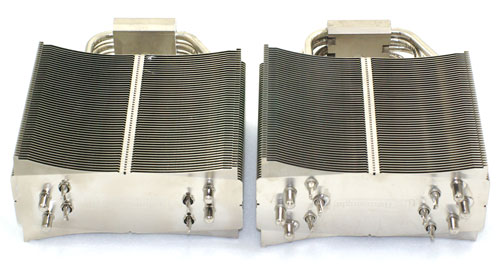
As you can see in the side-by-side comparison with the current Ultra 120, Thermalright has managed to add two more heatpipes to the Ultra 120 Extreme, raising the total heatpipes from four to six. Everything else about the Ultra 120 Extreme seems to be exactly the same as the existing Ultra 120.
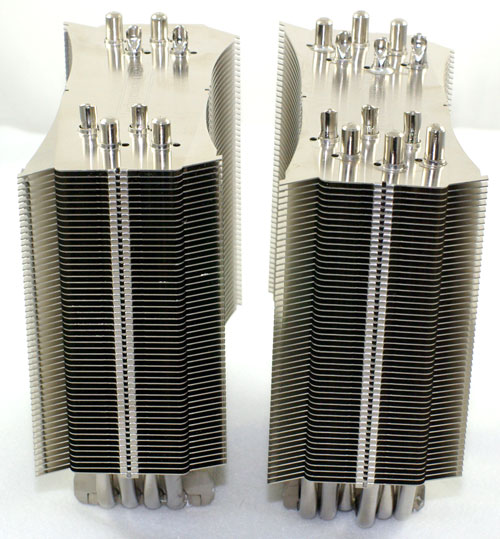
It is always good to see more heatpipes for cooling - particularly in a design that has proven to perform very well as the Ultra 120 has. We wondered, however, exactly how much difference two added heatpipes could make in the performance of the Ultra 120. Was it enough of a difference to justify Thermalright's enthusiasm about the new design?
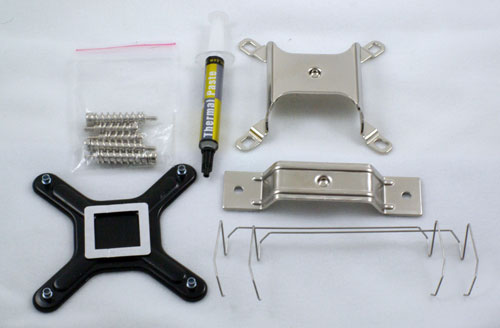
Thermalright also updated the kit with the Ultra 120 Extreme. Where the AM2 adapter is an optional accessory with the Ultra 120 kit, the Socket 775, AM2, and AMD 754/939/940 adapters are all included with the Ultra 120 Extreme.
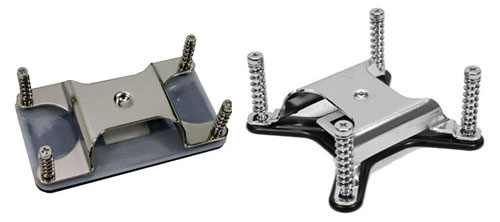
The addition of two extra heatpipes is pretty straightforward. However, the location of the added pipes does create some issues with the Intel socket 775 adapter carried over from the current Ultra 120 kit. The adapter frankly won't fit through the heatpipes in the new design. We actually had to bend the Socket 775 adapter to mount the Ultra 120 Extreme on a Core 2 Duo.
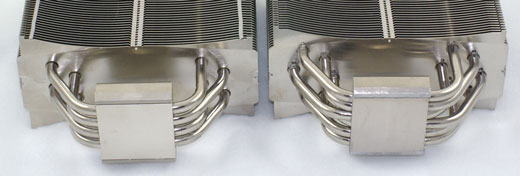
We have alerted Thermalright to the problem, and we sincerely hope they will make modifications to the Socket 775 bracket before shipping the Extreme kits to the retail channel. Those handy with tools will find a way to mount the Ultra 120 Extreme on a Socket 775, but most users will want an adapter that is easier to work with.

To isolate just the impact of the Extreme modification we tested with the same Scythe S-Flex fan used in the Thermalright Ultra 120 review. This excellent fan moves a lot of air, but still keeps noise low with the Sony developed Fluid Dynamic Bearing on the fan motor.
A few days later a package arrived from Taiwan in the stock Thermalright plain brown box. There was not even a new ID on the package for this new cooler, but Thermalright told us it would be called the Thermalright Ultra 120 Extreme. So what is improved on the new Ultra 120 Extreme?

As you can see in the side-by-side comparison with the current Ultra 120, Thermalright has managed to add two more heatpipes to the Ultra 120 Extreme, raising the total heatpipes from four to six. Everything else about the Ultra 120 Extreme seems to be exactly the same as the existing Ultra 120.

It is always good to see more heatpipes for cooling - particularly in a design that has proven to perform very well as the Ultra 120 has. We wondered, however, exactly how much difference two added heatpipes could make in the performance of the Ultra 120. Was it enough of a difference to justify Thermalright's enthusiasm about the new design?

Thermalright also updated the kit with the Ultra 120 Extreme. Where the AM2 adapter is an optional accessory with the Ultra 120 kit, the Socket 775, AM2, and AMD 754/939/940 adapters are all included with the Ultra 120 Extreme.

The addition of two extra heatpipes is pretty straightforward. However, the location of the added pipes does create some issues with the Intel socket 775 adapter carried over from the current Ultra 120 kit. The adapter frankly won't fit through the heatpipes in the new design. We actually had to bend the Socket 775 adapter to mount the Ultra 120 Extreme on a Core 2 Duo.

We have alerted Thermalright to the problem, and we sincerely hope they will make modifications to the Socket 775 bracket before shipping the Extreme kits to the retail channel. Those handy with tools will find a way to mount the Ultra 120 Extreme on a Socket 775, but most users will want an adapter that is easier to work with.

To isolate just the impact of the Extreme modification we tested with the same Scythe S-Flex fan used in the Thermalright Ultra 120 review. This excellent fan moves a lot of air, but still keeps noise low with the Sony developed Fluid Dynamic Bearing on the fan motor.










54 Comments
View All Comments
Ender17 - Wednesday, March 7, 2007 - link
I'm basing my statements off of SPCR's results.You can read their testing methodology here:
http://www.silentpcreview.com/article687-page1.htm...">http://www.silentpcreview.com/article687-page1.htm...
Wesley Fink - Wednesday, March 7, 2007 - link
While we respect the quest for a silent PC, testing fans in a foam block isolated from power sources is not real world. It does allow isolation of the lowest possible noise that can be emitted by a component. However, in a system power supplies do generate noise, cases do vibrate with mounted fans, and the video card does have a fan.You can minimize all these variables in a specialized PC that is not overclocked,but many users want a system that is very competent, reasonably quiet, but still uses a power supply with a fan. That makes the PS the noise floor. The configuration (open/closed cases), measurement distance, and measurement method determines the dbA level. Our noise measuremtns aim at measuring a real world computer enviromment and they do not isolate the PS in another room for noise measurement. They should also be considered worst case noise in the cooler being tested.
Our test room has all other equipment turned off and only incandescent lights.
PCTechNow - Wednesday, March 7, 2007 - link
If you do not isolate the components for testing then why measure it all? There are so many variables within the case and your room that any measurements provided are worthless.It would be nice to see how these air coolers compare to water systems. Why is there not a review or at least a comparison in your results?Wesley Fink - Wednesday, March 7, 2007 - link
We measure and report total system noise with each cooler using a standardized test system that is typical of an enthusiast system. We have not evaluated individual fans.PCTechNow - Wednesday, March 7, 2007 - link
Is the noise level in your room and case always the same between test measurements? If you do not isolate the test parts and ensure the room noise level is equal then how are your results valid? I am not a gamer so I expect to have a quiet system. I do not think you are providing numbers that cater to the majority of people who use computers. It is hard to tell from any of your results if a unit is really quiet or not. The power supply is already at 38db so any cooler that is quieter than this will not be reported. Is there anyway to tell us if a cooler is quieter than 38db?Wesley Fink - Wednesday, March 7, 2007 - link
The noise level in my test room is always below the noise floor of the single standardized test system with the case side open. I measure the room noise each time before I begin system/cooler noise measurements.There is already a web site for users who are obsessed with system noise, and we are not a substitute. We are trying to address users who care about system noise and want to build a quiet PC on a relative basis - not those who make noise their only concern in choosing computer components.
Manufacturers are definitely doing a better job of addressing noise these days - mainly because users like our reders complain about high noise components and stop buying them. There are not many 62db fans around like the screamers that used to be common on Socket A builds.
I wish the northbrdge coolers were quieter - that is where the highest noise is these days. The Northbridge fan on the test EVGA 680i is the noisiest component in our system. It is so gbad we have to disconnect it before making any noise measurements on coolers.
PCTechNow - Wednesday, March 7, 2007 - link
What is your problem with not using quieter components in the test PC or even changing rooms? Fine with not catering to quiet pc users but at least get your noise floor down to something reasonable like 30db. I am sure I am not in the minority here but most of the boards used now are passively cooled so the two main noise issues in a pc are the cooler and power supply. I am not after total silence but having something that is not louder than the ambient noise in the room is important.gramboh - Thursday, March 8, 2007 - link
The review is fine for users like me, those that are going to build a PC, want it to be REASONABLY quiet, but also overclock and have a high end video card for gaming. If you browse the AT forums, a lot of the users fall into this bucket. Yes there are also silence enthusaists, HTPC etc. If I were building one of those systems I would be reading up on SPCR.The review is gauging an overall end user experience.
kmmatney - Wednesday, March 7, 2007 - link
"I am not after total silence but having something that is not louder than the ambient noise in the room is important."That doesn't really make sense - anything lower than the ambient noise will be pretty much silent. If you want a silent cpu, then go fanless. Most people have a power supply that makes noise, as well as video cards that make noise, and these reviews make sense.
bigpow - Wednesday, March 7, 2007 - link
I was absent for a one year and now I never see it being compared anymore..How is it compared to today's top coolers?
Is Scythe Infinity the new Ninja/p?